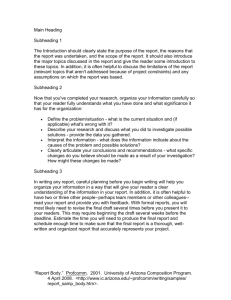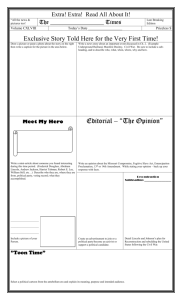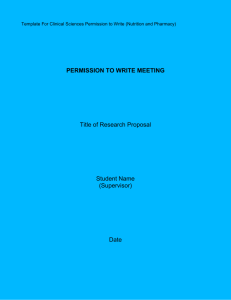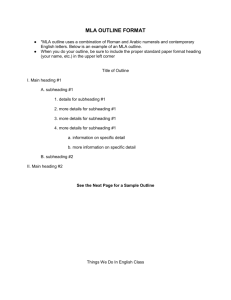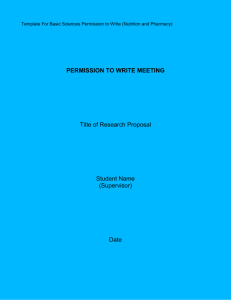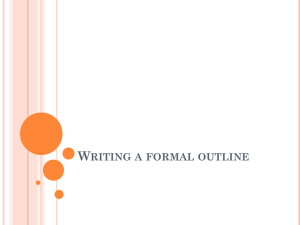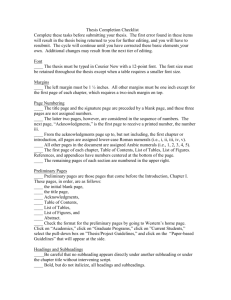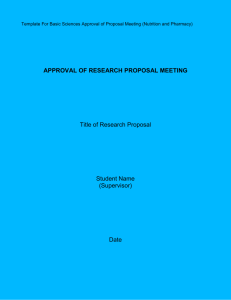Research Guide - phsmc
advertisement
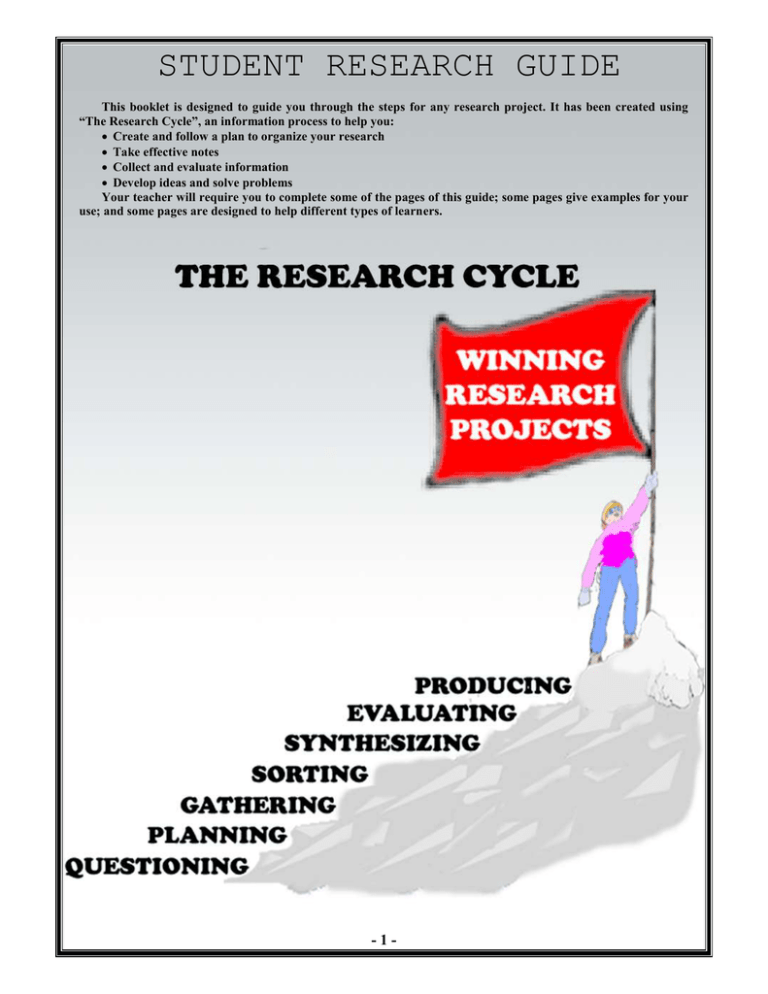
STUDENT RESEARCH GUIDE This booklet is designed to guide you through the steps for any research project. It has been created using “The Research Cycle”, an information process to help you: Create and follow a plan to organize your research Take effective notes Collect and evaluate information Develop ideas and solve problems Your teacher will require you to complete some of the pages of this guide; some pages give examples for your use; and some pages are designed to help different types of learners. -1- ANALYZE THE TASK What is the task? Do I work alone or in a group? Who is the audience? Has the teacher required a format for the final product? Yes No What must the final product be? e.g., Report, Speech, etc. When must the product be completed? Has the teacher set up checkpoints throughout the project? Yes No What are they? What do I have to hand in with the final product? Research Guide Note Cards Working Disk Other Draft Copy Works Cited Page What has the teacher required the final product will be? Oral How long must the presentation be? Must I use graphics, posters, etc. to enhance my presentation? Yes No Written What format must I use? Hand written Word processed How long must it be? Visual What format has the teacher required? If the teacher has not specified a format, see “Criteria for Determining the Form of Presentation” on page _____ and “Forms of Presentation” on page _________. QUESTIONING -2- BRAINSTORMING What do I already know about this topic? What more do I need to know to understand this topic? What are some related topics I could research? QUESTIONING -3- IDENTIFYING KEYWORDS AND SYNONYMS Write your research/thesis question: Go back and circle the keywords in your research/thesis question. Think about your keywords and synonyms for them that you might use if you do not locate your keyword, then fill in the chart below. List KEYWORDS Here List SYNONYMS Here 1. 1. 2. 3. 4. 5. 2. 1. 2. 3. 4. 5. 3. 1. 2. 3. 4. 5. 4. 1. 2. 3. 4. 5. PLANNING -4- SELECTING THE RIGHT SOURCES OF INFORMATION Range of Resources/Sources Complete these charts by filling in the various categories with potential sources or resources that will help you locate information on your topic. People Visuals (Posters, etc.) Places Publications (Print/Electronic) Observation Artifacts Technology Reference Sources you could consider using: Almanac Atlas Bibliography Biographical Dictionary Book of Quotations Dictionary Encyclopedia Geographical Dictionary Grolier Online Indexes ProQuest SIRS Discoverer SIRS Researcher Thesaurus World Book Encyclopedia PLANNING -5- GATHERING SOURCE INFORMATION Primary Sources: Person, Place, Artifact, etc. Who/What/Where Date Secondary Sources: Author Place Book Title Place Publisher Date Encyclopedia Title Article Title Date Vol. No. Page Nos. CD-ROM Author Title Date Publisher Internet Author Title of Entry http GATHERING -6- Date Created Date Visited USING CARDS TO GATHER INFORMATION WORKS CITED CARDS As soon as you begin to use a new information source, your should make a “Works Cited Card” for it. Generally, the card for print materials includes the following information about the source: Author, Title of the Work, Title of an Article, Publisher, Place of Publication, and Date of Publication. Non-print and online sources require additional information. Refer to pages 11 and 12 for the correct MLA format for all types of sources. SAMPLE: Teale, Edwin Way. The Golden Throng. New York: Dodd, Mead & Company, 1961. NOTE CARDS Use note cards to gather information from sources. Write on one side only of 3” x 5” or 4” x 6” cards. Have only one subject and one source on each card. Include on the card: 1) Name of subject, 2) Identification of source including the author’s name and a shortened title, 3) Notes you intend to use, and 4) Page (s) where the material is found. SAMPLE: Teale,45 Bees: Physical structure – general Three parts of body: 1. Head: antennae, eyes, mouth parts, brain 2.Thorax (middle body): legs & wings attached here 3. Abdomen: reproductive organs, heart, digestive organs, stinger “...the honeybee is a chemical factory. It is an elaborte tool kit. It is the possessor of remarkable abilities, still but dimly understood. GATHERING -7- CONCEPT MAP Using the information you have gathered about your research/thesis question, begin sorting out your ideas by creating a concept map. At the center of your map will be your research/thesis question. Branching out from the research/thesis question, you will create headings and subheadings to further define your thoughts. Feel free to add headings and subheadings if you need them. Subheading Subheading Subheading Subheading Subheading Subheading Heading Heading Topic of Research/ Thesis Question Heading Subheading Heading Subheading Subheading Subheading Subheading Subheading SORTING RESEARCH OVERVIEW -8- Now, you will begin to put the pieces of your research puzzle together. Using the Concept Map you have just created, determine the order in which you can most logically present your ideas. Complete the chart below by arranging the headings and subheadings you have selected. Take note of whether you have located sufficient information to support the point of each of your headings and subheadings. Research/Thesis Question: Heading 1 Subheading a) Subheading b) Subheading c) Heading 2 Subheading a) Subheading b) Subheading c) Heading 3 Subheading a) Subheading b) Subheading c) Heading 4 Subheading a) Subheading b) Subheading c) SYNTHESIZING REFLECTING & REFINING -9- EVALUATING WHETHER THE INFORMATION GATHERED IS SUFFICIENT The information I have found is TOO LITTLE to answer my research/thesis question. or TOO MUCH TOO LITTLE If I have found too little information, what do I need to do? (Check all that apply.) Broaden my research/thesis question. Review my keywords and synonyms to see if I have missed important ways to describe my research/thesis question. Look in more sources of information on my topic to answer my question. TOO MUCH If I have found too much information, what do I need to do? (Check all that apply.) Re-scan the information gathered again to weed out less useful sources. Narrow my research/thesis question. Review my keywords and synonyms to see if I have chosen the most important words for my research/thesis question. (See page 4.) Review my search strategy in terms of sources (for example library catalogs, article databases, web search engines, etc. to see if I have chosen the most appropriate ones for my research/thesis question. SYNTHESIZING CITING SOURCES - 10 - MLA Format In-Text References MLA recommends an in-text reference system directing readers to a “Works Cited” list at the end of the written work. The in-text reference includes an author name and a location in the text being cited. The specific page numbers of a reference are always listed in the citation unless the reference is to the source as a whole. The parenthetical citations are usually placed at the end of the sentence rather than immediately after the information being cited, even when the author’s name is included in the text. Single author: The Shining’s reputation increased upon closer inspection of Kubrick’s techniques (Manchel 70). OR According to Manchel, The Shining’s reputation increased upon closer inspection of Kubrick’s techniques (70). Two or three authors: A few scholars still believe that the world is flat (Jones, Smith and Johnson 453). Four or more authors: ...the writers as a group seemed to reach for robust, earthy ways of writing (Flower et al 42-46). Works Cited JOURNAL ARTICLE Manchel, Frank. “What About Jack? Another Perspective on Family Relationships in Stanley Kubrick’s The Shining.” Literature Film Quarterly 23 (1995): 68-78. FULL TEXT JOURNAL ARTICLE FROM PROQUEST DIRECT Klinger, David A. “Policing Spousal Assault.” The Journal of Research in Crime and Delinquency 32 (1995): 427+. UMI-ProQuest Direct. Online Aug. 2, 1999. MAGAZINE ARTICLE Saletan, William. “The Dark Side.” Mother Jones Jan.-Feb. 1996:60+ (note: a plus sign is used after the first page number when paging is not continuous.) NEWSPAPER ARTICLE Radzinsky, Edvard. “Who Killed the Romanovs?” New York Times 20 Jul. 1991, late ed.: A19. Continued on next page PRODUCING CITING SOURCES cont. FULL TEXT NEWSPAPER ARTICLE FROM PROQUEST DIRECT - 11 - Warmbold, Carolyn Nizzi. “Lore of Titanic Fills Many Books.” Atlanta Constitution 14 Apr. 1997: C8. UMI-ProQuest Direct. Online. Aug. 2, 1999. FULL TEXT NEWSPAPER ARTICLE FROM NEWSBANK NEWSFILE Herrar, Clara G. “Alien Abductees Gather to Share Talk of Their Experiences.” Fort Worth StarTelegram 9 Aug. 1998, final am ed.: 1. NewsBank NewsFile Collection. Online. 2 Aug. 1999. AUTHORED BOOK McNickle, D’Arcy. Runner in the Sun. Albuquerque: U of New Mexico P, 1987. CHAPTER OR ARTICLE IN AN EDITED BOOK OR ANTHOLOGY Acoose, Janice. “Halfbreed: A Revisiting of Maria Campbell’s Text from an Indigenous Perspective.” Looking at the Words of Our People: First Nations Analysis of Literature. Ed. Jennette Armstrong. Penticton, BC: Theytus, 1993. 137-150. ENTRY FROM A SPECIALIZED ENCYCLOPEDIA OR DICTIONARY McIntosh, Christopher. “I Ching.” Encyclopedia of the Unexplained: Magic, Occultism and Parapsychology. Ed. Richard Cavendish. New York: Arkana, 1989. ENTRY FROM AN ONLINE ENCYCLOPEDIA OR DICTIONARY “Millennium.” Britannica Online. 15 Jan. 1998 <http://www.eb.com/> GOVERNMENT DOCUMENT United States. Office of the Secretary of Defense. Proliferation: Threat and Response. Washington: GPO, 1997. DOCUMENT FROM A MICROFORM COLLECTION (ERIC) McWhirter, Ellen Hawley. Counseling for Empowerment. Alexandria, VA: American Counseling Association; Springfield, VA: ERIC Document Reproduction Service, 1994. ED403513. VIDEOCASSETTE Citizen Kane. Dir. Orson Welles. Perf. Orson Welles, Joseph Cotton, and Dorothy Comingore. 1941. Videocassette. Nostalgia Merchant, 1985. WEBSITE McEldowney, Philip. Women in Cinema: A Reference Guide. Dec. 1994. 2 Aug. 1999. <http://poe.acc.virginia.edu/~pm9k/libsci/womFilm.html>. Note: The last date in a website citation is the date of your visit. If you cannot find some of the information used in an electronic citation, cite what is available. PRODUCING CRITERIA FOR DETERMINING FORM OF PRESENTATION - 12 - Six questions I need to consider in choosing a form of presentation: 1. Who is my audience and which form of presentation is best for that audience? 2. What is the purpose of my presentation? Is it intended to inform, persuade, entertain, explain, or a combination of several of these? 3. What are the possible forms of presentation available to me to communicate my information given the answers to the first two questions? Refer to pages 14 and 15 for a list of various forms of written and visual presentations. 4. Of these forms of presentation, which forms would be the most effective to communicate my information? 5. Given my choices above, what logistical considerations do I need to consider for each of these possibilities: a. What space will I need to display my presentation? b. How much time will it take to complete the form of presentation I am considering? c. What materials will I need for the form of presentation and are they available? d. When and where will I work on this presentation: at home, at school or both? e. What equipment is needed for this form of presentation? Is it compatible with equipment I use at home? 6. What is my final choice? PRODUCING WRITTEN FORMS OF PRESENTATION - 13 - NARRATIVE EXPOSITORY Stories Research Report Essays PERSONAL PERSUASIVE GUIDELINES Personal Letter Editorial Rules Magazine Article Journal Advertisement Instructions Character Portrait Newspaper Article Diary Letter to the Editor Script Book Log Proposal Story Endings Biography Autobiography First Person Narrative Business Letter Resume PRODUCING NON-WRITTEN FORMS OF PRESENTATION TECHNOLOGY DRAMATIC THREEVISUAL DIMENSIONAL - 14 - VERBAL GRAPHIC ORGANIZER Multimedia Presentation Role Play Sculpture Drawing Interview Concept Map Slide Show Tableau Construction Cartoon Speech Storyboard Newscast Play Display Diagram Debate Outline Computer Graphic Dramatization Diorama Painting Discussion T-chart Video Skit Collage Poster Oral Presentation KWL Chart Audiotape Collection Photograph Poetry Reading Venn Diagram Commercial Scrapbook Postcard Teach A Lesson Note Taking Filmstrip Game Map Dialogue Chart Model Design Song Timeline Reader’s Theater Graph Rap Data Table Grid/ Matrices PRODUCING SELF-ASSESSMENT Questioning: I have appropriately analyzed the task. I have used brainstorming to form an effective question. - 15 - YES NO Planning: I have selected sufficient keywords and synonyms. I have identified resources relevant to my question. YES NO Gathering: I have located all bibliographic information for my sources. I have recorded bibliographic sources correctly. I have used note cards to document facts and data. YES NO Sorting: I have organized note cards in a meaningful way. I have generated appropriate headings and subheadings. YES NO Synthesizing: I have assessed the sufficiency of the information I gathered. I have logically organized my headings and subheadings. YES NO Producing: I have employed appropriate vocabulary. I have used correct grammar and spelling. I have cited sources properly. I have determined the most effective form of presentation. I have shown that I completed the task requirements. I have created a presentation that is logical and well organized. I have produced a presentation showing originality. YES NO Comments: EVALUATING - 16 -
